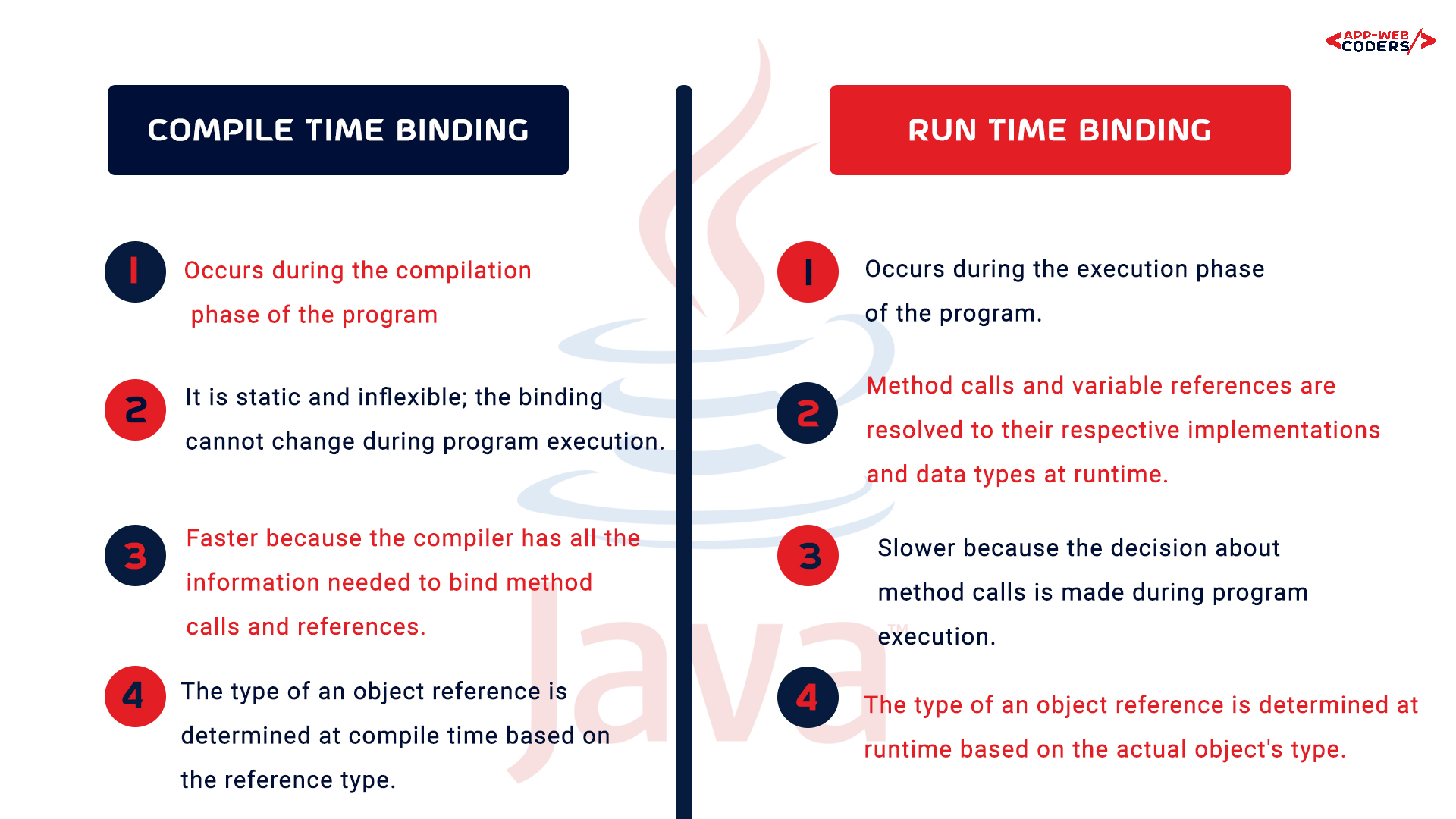Compile-Time-Binding and Run-Time-Binding in JAVA
 Appweb Coders
Appweb Coders
In Java, binding refers to the process of associating a method call or variable reference with its corresponding implementation or data type. This binding can occur either at compile-time or at run-time, giving rise to two important concepts: Compile time binding is also called Early Binding or Static Binding and Run time binding is also called Late Binding or Dynamic Binding. Understanding the differences between these binding types is crucial for Java developers to write efficient, flexible, and maintainable code. In this article, we will explore the concepts of early and late binding in Java, their implications, and real-world examples to grasp their significance in the programming world.
Why is the binding of static, final and private methods always a static binding?
Static, final, and private methods in Java always exhibit static binding due to the nature of their declarations and access control.
Static Methods: Static methods are associated with the class itself rather than an instance of the class. Since they are resolved at compile-time based on the reference type, static binding is used. The compiler can determine the method call based on the reference type, making the binding static and efficient.
Final Methods: Final methods are declared to be not overridden in subclasses. Because their implementation cannot be changed in derived classes, the compiler can directly associate the method call with the class during compilation, leading to static binding.
Private Methods: Private methods are not accessible outside their class. Since they are bound to their own class during compilation and cannot be overridden or accessed from subclasses, the binding remains static.
In summary, static, final, and private methods are bound at compile-time due to their inherent characteristics. Their binding is static because the decisions regarding method calls are made during compilation and remain fixed throughout the program’s execution.
Early Binding / Static Binding / Compile Time Binding
Early binding, also known as static binding, takes place during the compilation phase of a Java program. It refers to the association of method calls and variable references with their corresponding implementations and data types based on the information available in the source code. The key characteristic of early binding is that the binding is determined and fixed at compile time.
Example of association
class Base {
void display()
{
System.out.println("AppWeb Coders Base Class");
}
}
class Child extends Base{
void display()
{
System.out.println("AppWeb Coders Child Class");
}
public static void main(String[] args) {
// association of the object
Base baseClassObject = new Base();
baseClassObject.display();
}
}
How Early Binding Works:
During compilation, the Java compiler analyzes the reference types and resolves method calls and variable references based on their declared types. The compiler enforces strict type-checking to ensure that the method being called or the variable being accessed exists in the class hierarchy and is compatible with the reference type.
In the given example, the method “display” in the Base class is unambiguously linked to the object of the Base class. As a result, the compiler faces no ambiguity in determining which method to execute since it is solely associated with the Base class object.
Here is the Output.
AppWeb Coders Base Class
Advantages of Early Binding:
Efficiency: Early binding is generally faster than late binding since the compiler has all the information it needs to bind method calls and references. This efficiency contributes to the overall performance of the program.
Early Error Detection: The strict type checking during compilation helps detect errors early in the development process. Any inconsistencies or mismatches in method signatures or variable types are identified and flagged as compile-time errors.
Limitations of Early Binding:
- Lack of Flexibility: Early binding is static, meaning the binding decisions made during compilation remain constant throughout the program’s execution. This lack of flexibility can be a limitation in certain scenarios where dynamic behavior is required.
Just Another Example of Compile Time Binding
class Animal {
void sound() {
System.out.println("Animal makes a sound");
}
}
class Dog extends Animal {
@Override
void sound() {
System.out.println("Dog barks");
}
}
public class Main {
public static void main(String[] args) {
Animal animal = new Dog();
animal.sound(); // Output: "Animal makes a sound"
}
}
In this example, the reference animal is of type Animal, but it points to an object of type Dog. During compilation, the method call animal.sound() is resolved based on the reference type Animal. Consequently, the output is “Animal makes a sound,” as the decision is made at compile time.
As private,final and static modifiers binds to the class level so methods and variables uses static binding and bonded by compiler while the other methods are bonded during runtime based upon runtime object.
In general we can say that overloaded methods are bonded using static binding while overridden methods are bonded using dynamic binding.
Late Binding / Dynamic Binding / Runtime Binding

Late binding, also known as dynamic binding, occurs during the execution phase of a Java program. Unlike early binding, late binding determines the method calls and variable references based on the actual type of the objects at runtime. This dynamic nature enables flexibility, polymorphism, and inheritance in Java, making it a powerful object-oriented programming language.
How Late Binding Works:
During runtime, the Java Virtual Machine (JVM) identifies the actual type of objects and resolves method calls and variable references accordingly. This enables the program to choose the appropriate method implementation based on the runtime type of the object, rather than the reference type.
Advantages of Late Binding
Polymorphism and Flexibility: Late binding allows for polymorphism, where a method call on a superclass reference can lead to the invocation of an overridden method in a subclass. This flexibility enhances code reusability and maintainability.
Run-Time Decisions: Late binding provides the ability to make decisions at runtime, enabling dynamic behavior and adaptability in the program.
class Shape {
void draw() {
System.out.println("Drawing a shape");
}
}
class Circle extends Shape {
@Override
void draw() {
System.out.println("Drawing a circle");
}
}
class Square extends Shape {
@Override
void draw() {
System.out.println("Drawing a square");
}
}
public class Main {
public static void main(String[] args) {
Shape shape1 = new Circle();
Shape shape2 = new Square();
shape1.draw(); // Output: "Drawing a circle"
shape2.draw(); // Output: "Drawing a square"
}
}
In this example, the draw() method is dynamically bound based on the actual type of the objects (Circle and Square). This results in the appropriate method being executed, showcasing the power of late binding.
| Sr. No | Compile Time Binding | Run Time Binding |
| 1 | Static polymorphism, also known as compile-time polymorphism, is a form of polymorphism in which the method to be called is determined during the compile-time. | Dynamic polymorphism, also known as runtime polymorphism, is a form of polymorphism in which the method to be called is determined at runtime. |
| 2 | The binding occurs during the compilation phase. | The binding occurs during the execution of the program. |
| 3 | The binding process does not involve the actual object. | The binding process relies on the actual object. |
| 4 | Private, static, and final methods demonstrate static binding since they cannot be overridden, resulting in their association being determined during compilation. | Methods other than private, static, and final exhibit dynamic binding because they can be overridden, leading to the decision about their association being made at runtime. |
| 5 | It is also known as early binding since the binding takes place during compilation. | It is commonly referred to as late binding since the binding process occurs during runtime. |
| 6 | Method overloading serves as a prime example of static binding. | Method overriding exemplifies dynamic binding. |
| 7 | The execution speed is high. | The execution speed is slow. |
Conclusion
In Java, binding is a fundamental concept that determines the association of method calls and variable references with their respective implementations and data types. Early binding (static binding) occurs during compilation, ensuring efficiency and early error detection but lacks the flexibility provided by late binding (dynamic binding). Late binding, on the other hand, enables dynamic behavior, polymorphism, and adaptability in the program, making it a powerful feature for writing flexible and maintainable code.
As Java developers, understanding the differences between early and late binding empowers us to design robust and efficient software solutions while taking advantage of the language’s object-oriented capabilities. By leveraging the right type of binding in appropriate scenarios, developers can create elegant and extensible code that meets the ever-evolving demands of modern software development.
Thank you for taking the time to read our article. If you have any lingering questions or uncertainties regarding Compile Time Binding and Run Time Binding in Java, feel free to ask in the comment section, and our team will be more than happy to assist you.
Subscribe to my newsletter
Read articles from Appweb Coders directly inside your inbox. Subscribe to the newsletter, and don't miss out.
Written by

Appweb Coders
Appweb Coders
Performance-driven & Result Oriented Software Professional with extensive experience in designing, analysing, developing, delivering and supporting fast paced Web and Mobile Applications.